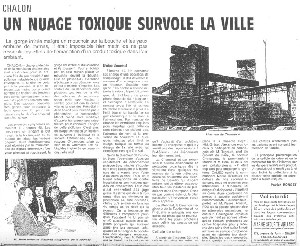At 7.10 am, 300 kg of phosphorus trichloride (PCl3) spilled over from a measuring tank during a loading operation and hydrolysed in the sewers of a chemical plant. The day before, 1,320 kg of 2-ethyl-hexanoic acid was introduced into a reactor.
On the day of the accident, an experienced operator added 466 kg (293 l) of PCl3 from metering unit D2, located above reactor R2 and connected to a pump on a storage tank (22 m³) located roughly 20 m from the workshop. This pump is used to transfer PCl3 to the workshop’s production lines and unload the storage tanks. The operator checked the level (using a glass tube and mirror), stopped the pump then adjusted the flow of PCl3 (10 l/min.) into the reactor. He returned to the ground level of the workshop and prepared to drain reactor R1 when he was sprayed with PCl3. He noted a release of white fumes and activated the pump’s emergency stop button upon exiting the building. Another employee ensured that the pump was stopped by removing the fuses from the control circuit. The flooding of the sewer system lead to the hydrolysis of PCl3 into HCl, H3PO4 and HPO3. The fog prevented dispersion of the toxic cloud that formed, which began drifting toward the city. Effects were observed 1,500 m from the release point. Nineteen individuals, including 2 employees were intoxicated. The accident occurred when part of the installations were restarted following a 4-month shutdown period. The operator attributed the accident to the untimely restart of the PCl3 transfer pump.
The inquiry revealed numerous installation design problems: excessive max. pump delivery (300 l/min.) in relation to the capacity of the metering unit (500 l) and the quantity needed for each batch (293 l), poor workstation ergonomics (control cabinet not visible from the base of the installations…), the complexity of the control system (numerous timers installed which could present possible interactions), neutralisation of alarms, the disappearance long ago of the diaphragm limiting the metering unit’s throughput, the presence of a 2nd diaphragm in the overflow line of this tank unnecessarily reducing its diameter from 80 to 20 mm (an installation error committed during maintenance). These modifications were not indicated on the drawings and the operators were unfamiliar with them. The untimely restart of the PCl3 pump appears to have caused the overfilling. Manufacturing operation was abandoned.
Download the detailed report in .pdf format (172 Kb)





